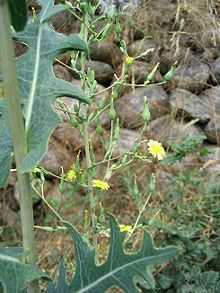Lactuca serriola
| Lactuca serriola | |
|---|---|
 | |
| Scientific classification | |
| Kingdom: | Plantae |
| (unranked): | Angiosperms |
| (unranked): | Eudicots |
| (unranked): | Asterids |
| Order: | Asterales |
| Family: | Asteraceae |
| Tribe: | Cichorieae |
| Genus: | Lactuca |
| Species: | L. serriola |
| Binomial name | |
| Lactuca serriola L. | |
| Synonyms | |
|
L. scariola[1] | |
Lactuca serriola, also called prickly lettuce,[2] milk thistle[2] (not to be confused with Silybum marianum, also called milk thistle) compass plant,[2] and scarole,[2] is an annual or biennial plant, slightly foetid, that is commonly considered a weed of orchards, roadsides and field crops. The closest wild relative of cultivated lettuce (Lactuca sativa L.). The leaves grow along a spiny stem and get progressively smaller as they reach its top. They emit latex when cut. Many flowers are produced and usually appear in the upper part of the plant.
It is known as the compass plant because in the Sun the upper leaves twist round to hold their margins upright.[3]
It is native to Europe, Asia, and north Africa, and has become naturalized elsewhere.[2]
Description

It has a hairless reddish stem, containing a milky latex, growing from 30 to 200 cm.
The leaves are oblong lanceolate, often pinnated (especially for the lower leaves), waxy grey green. Fine spines are along the edges. The undersides have whitish veins.
The flower heads are 11 to 13mm wide, are pale yellow, often tinged purple. The bracts are also often tinged purple. It flowers from July until September.
The achenes are grey, bristly tipped. The pappus is white with equal length hairs.[4]
Culinary and medicinal uses
The plant can be eaten as a salad, although it has something of a bitter taste. Young leaves can be eaten raw or cooked.[5] However, its presence in some ancient deposits has been linked more to its soporific properties which might suggest ritual use. The Ancient Greeks also believed its pungent juice to be a remedy against eye ulcers and Pythagoreans called the lettuce eunuch because it caused urination and relaxed sexual desire. The Navajo used the plant as a ceremonial emetic.[6] In the island of Crete in Greece the leaves and the tender shoots of a variety called maroula (μαρούλα) or agriomaroulo (αγριομάρουλο) are eaten boiled.[7] It is used by a growing number of Jews and the Samaritans as the Maror (bitter herb) on Pesach.[citation needed]
History

The Egyptian god Min is associated with this variety of lettuce. Also, archaeobotanical evidence in Greek archaeological contexts is scanty, although uncarbonised seeds have been retrieved from a 7th-century BC deposit in a sanctuary of Hera on Samos. It is also described by Theophrastus. In mythology, Aphrodite is said to have laid Adonis in a lettuce bed, leading to the vegetable's association with food for the dead.
References
- Everitt, JH; Lonard, RL; Little, CR (2007). Weeds in South Texas and Northern Mexico. Lubbock: Texas Tech University Press. ISBN 0-89672-614-2.
- Fragiska, M (2005), "Wild and Cultivated Vegetables, Herbs and Spices in Greek Antiquity", Environmental Archaeology 10 (1): 73–82, doi:10.1179/146141005790083858.
- ↑ Lactuca serriola L., US: Department of Agriculture, retrieved April 2, 2012.
- ↑ 2.0 2.1 2.2 2.3 2.4 "GRIN Taxonomy". USDA.
- ↑ Blamey, Marjorie; Fitter, Richard; Alistair (2003). Wild Flowers of Britain and Ireland. London: A&C Black. pp. 294–5. ISBN 0-7136-5944-0.
- ↑ Rose, Francis (1981). The Wild Flower Key. Frederick Warne & Co. pp. 390–391. ISBN 0-7232-2419-6.
- ↑ "Lactuca serriola". Survival and Self Sufficiency. AU. Retrieved 9 September 2011.
- ↑ "Lactuca serriola", Ethnobotany, U Mich.
- ↑ Stavridakis, Kleonikos G [Κλεόνικος Γ. Σταυριδάκης] (2006). Η Άγρια βρώσιμη χλωρίδα της Κρήτης [Wild edible plants of Crete]. Crete: Rethymnon. ISBN 960-631-179-1.
External links
- Prickly Lettuce on Virginia Tech Weed Identification Guide
- Profile: Lobed Prickly Lettuce (Lactuca serriola) Photos, Drawings, Text. (Wild Plants of Winnipeg from Nature Manitoba)
- Jepson Manual Treatment
- USDA Plants Profile
- UC Davis IPM
- Photo gallery
| Wikimedia Commons has media related to Lactuca serriola. |